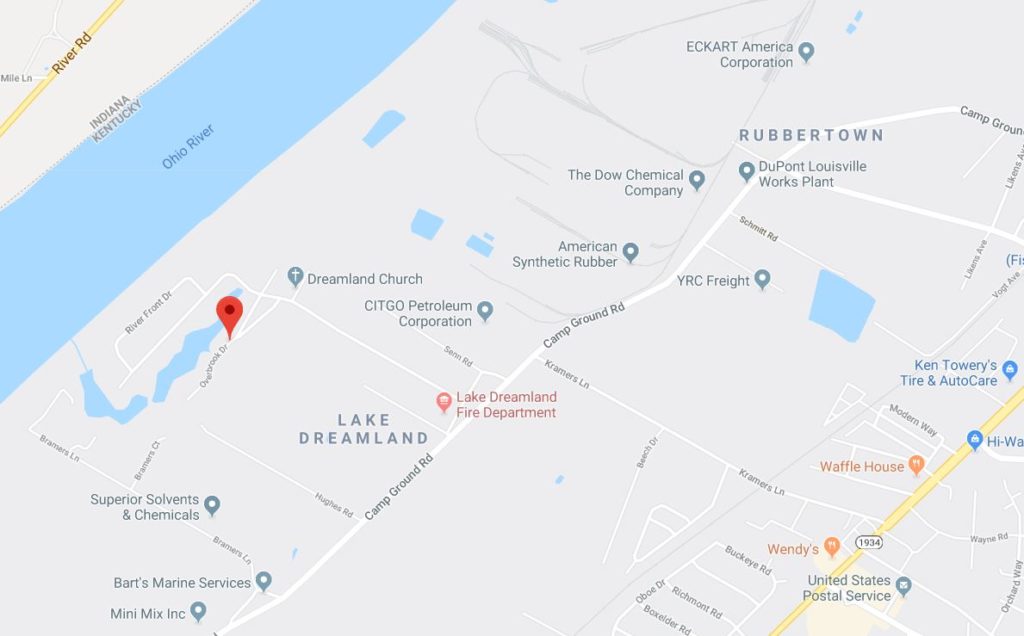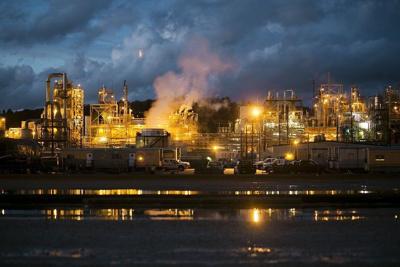Part 2 – The Power of Denial
When I mentioned to my dad that I was researching DuPont, Teflon, and impacts on health, he told me that when he was a kid, his family lived in the shadow of the Louisville works at (I still can’t believe this name) Lake Dreamland. I had never heard this story before, and I was horrified. He said that while his family lived there, he and his friends would sneak into the dumping grounds of a number of factories nearby (including DuPont) and play with whatever disposed items they could find. He described hearing the sirens going off at the DuPont factory and then seeing orange effluent come out of their pipes, going straight into the Ohio river. He then proceeded to list a handful of his friends who had since died of brain cancer.
Now, one could argue that a bunch of eight-year-old boys should not have been sneaking on to private property with who-knows-what kind of dangerous materials, and that the gates to the property were protecting them by keeping them out. But what of the communities around the plant that were exposed to chemical dumping without any protections? What of the families living miles downriver who had no idea that they were ever in harm’s way?
Corporate Response and Actions
According to the documentary “The Devil We Know,” DuPont knew their chemical C8 was going directly into the Ohio River and was not telling anyone about it. In fact, one person interviewed on the subject said that the company was responsible for dumping so much chemical into waterways that they had no idea how much had actually been dumped.[1] (Again, this week’s post will contain information largely from that documentary, unless otherwise noted, and again, there may be movie spoilers for “Dark Waters.”[2] I am writing this post before the movie has even been released, so I can’t speak to movie content.)

In 2000, 3M decided to stop making Scotchgard on the basis that the perfluorinated chemicals, such as PFOS (perfluorooctanesulfonic acid, the key ingredient in Scotchgard) and PFOA (C8) were biopersistent, meaning they would not break down in nature, and could easily get into the bloodstream of people exposed to them. 3M presented study data to the EPA, showing effects on lab rats. When the EPA responded with concern about the effects of these chemicals, the two organizations reached an agreement that 3M would take their production of PFOS and PFOA offline. 3M agreed to this course of action, despite the fact that it would mean hundreds of millions of dollars in lost revenue as a result.
In 2002, as 3M made good on their agreement with the EPA, DuPont picked up where they left off. “That very same year,” according to the documentary, “DuPont began producing C8 at its plant in Fayetteville, North Carolina.” DuPont’s conclusion was that developing and launching a new product would be too expensive for the company. As C8 was still unregulated, DuPont determined that it was in their best financial interest to continue producing it. As one internal memo stated, “C-8 is the devil we know.”

Regulation (or lack thereof)
It is concerning to think that this chemical was still unregulated in the light of lab studies that identified C8 as an animal carcinogen and possible human carcinogen. DuPont pressed forward in the absence of any regulation for perfluorinated chemicals and maintained their position that C8 was not harmful to humans: “based on our assessment of the science, we do not believe this to pose any risk.” They had their own company scientists appear on the news and state that “chemicals that have an effect on animals don’t necessarily have a similar effect on humans.”
Eventually a relationship grew between DuPont and the EPA that raised questions around conflict of interest. One commentator referred to the connection as a “revolving door” that existed between the EPA and DuPont. For example, Mike McCabe, who was deputy administrator of the EPA from 2000 to 2001, then went on to do consulting work for DuPont, specifically managing the company’s “communications and C8 strategy with the EPA.” According to McCabe’s testimony in a 2007 deposition, DuPont took advantage of inside information from former EPA employees and used it in shaping the conversation around C8.[5]

The growing relationship and connection between the two organizations was referred to as “corporate capture,” including the sharing of documents, information, and even quotes for the EPA to put into press releases about the safety of C8. One uncovered communication from DuPont said “we need EPA to quickly (like first thing tomorrow) say the following: Consumer products sold under the Teflon brand are safe … Further, to date there are no human health effects known to be caused by PFOA.” McCabe stated it was “customary” for the EPA to ask for quotes for press releases.
It wasn’t until the general public got involved that there was any movement in addressing the safety of these chemicals. In 2001 Parkersburg resident Joe Kiger led a class action lawsuit against DuPont with the help of attorney Rob Bilott, our protagonist in “Dark Waters,” who was by then working with Wilbur Tennant (the cattle farmer mentioned in last week’s post). And that is where we will pick up next time.
What do you think about the connection between perfluorinated chemicals and various illnesses such as cancer? Do you know anyone who has lived near a plant, like my dad did? I would love to hear your stories if you’re willing to share.
Thanks for reading!
[1] https://en.wikipedia.org/wiki/The_Devil_We_Know
[2] https://en.wikipedia.org/wiki/Dark_Waters_(2019_film)
[3] https://www.google.com/maps/place/Lake+Dreamland,+Louisville,+KY
[4] https://www.jammediaone.com/5-reasons-to-avoid-microwave-popcorn/
[5] https://theintercept.com/2015/08/20/teflon-toxin-dupont-slipped-past-epa/
[6] https://www.wvgazettemail.com/news/special_reports/epa-reaches-new-c-deal-with-dupont/article_4ac38eef-4f14-5fb9-aea3-b3ae58f36176.html
0 Comments